Most Influential, Significant
and Important Films in American Cinema
(chronological by time period and film title)
|
|
Title Screen
|
Film Title/Year/Director/Length/Studio,
Descriptions of Influence/Significance |
Poster
|
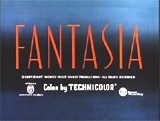
|
Fantasia (1940)
d. Various directors, 124 minutes, Walt Disney Pictures
- Disney's ground-breaking
animated feature-length "concert" film
milestone, with great works of Western classical music, was an
outgrowth of the "Silly Symphony" series.
- An ambitious
experiment to try to popularize classical music, especially by
accompanying it with animation. It integrated eight magnificent
classical musical compositions interpreted with enchanting, exhilarating,
and imaginative, artistically-choreographed animation.
- The film, with a production cost of more than $2
million (about four times more than an average live-action picture),
initially failed at the box-office, partially due to the expensive
installation of "Fantasound" sound
reproduction equipment in theatres. The "Fantasound" 'stereo-like',
multi-channel soundtrack was an optical 'surround-sound' soundtrack
printed on a separate 35mm reel from the actual video portion of the
film. It
was the first American film to use stereophonic sound as well as the
first and only film recorded in Fantasound.
- The film received a special certificate at the 1941
Academy Awards for its revolutionary Fantasound (early stereo).
- Originally, the film was to consist of only the
classic Mickey Mouse segment: "The Sorcerer's Apprentice."
- The only Walt Disney animated feature film that
was two-hours long, at 124 minutes.
- Often imitated or duplicated - e.g., Disney's own
'unofficial' sequel Make Mine Music (1946), Bruno Bozzetto's Allegro
non troppo (1976), parts of The Land Before Time (1988).
|

|

|
Citizen Kane (1941)
d. Orson Welles, 119 minutes, RKO Radio Pictures/Mercury
Productions
- A fresh, sophisticated, and classic masterpiece,
and probably the world's most famous and highly-rated film, with
its many remarkable scenes and performances, cinematic and narrative
techniques and experimental innovations (in photography, editing,
and sound). Often considered the "greatest film
ever made" on
most 'best of' lists.
- A prime example of the director-centric auteur
theory before
it was clearly defined decades later - it showcased the achievements
of a maverick director-cowriter-producer-star in one film, 25 year-old
independent wunderkind Orson Welles, who was the controlling
author of the film (not the studio, screenwriter, producers,
or others) - it was his debut feature film over which he was
given total freedom by RKO. With his four Academy Awards nominations
(Best Picture-producer, Best Actor, Best Director, and Best Original
Screenplay), Welles became the first individual
to receive simultaneous nominations in those four important categories.
- The innovative, bold film is an acknowledged milestone
in the development of cinematic technique, with
many advances in cinematic movie-making. It brought together and consolidated
everything in 'film-language' up until that time, and then broke some
new ground with deep focus photography, unconventional lighting,
including chiaroscuro, lengthy takes, low-angled shots revealing
ceilings in sets, sophisticated directional sound editing, overlapping
dialogue, the sound technique termed "lightning-mix," elaborate
camera movements, and flashbacks, flashforwards and non-linear
narrative story-tellin (shot
from various viewpoints).
- The film began with just a title screen - no performer
names - an unprecedented thing in the early 1940s, although common
place today.
- Welles was a trailblazer for future film-makers
who wanted to expand the boundaries of film, such as Francis Ford
Coppola, Martin Scorsese, and Quentin Tarantino.
- A great example of how external forces can ruin
(or help) a film's chances - i.e., publishing tycoon William Randolph
Hearst accused the film of wrongly portraying him as a ruthless,
publishing tycoon who died alone in the castle.
|

|
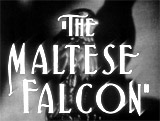
|
The Maltese Falcon (1941)
d. John Huston, 100 minutes, Warner Bros.
- One of the most popular, stylistic and best classic
detective mysteries ever made - a mixture of
mystery, romance, and thriller.
- Many film historians consider
it the first major dark film
noir production
in Hollywood - although it had antecedents. Some of the other most
influential noirs of the time period included Double Indemnity
(1944) and The Blue Dahlia (1946) (with Alan Ladd).
- The low-budget film reflected the remarkable directorial
debut of John Huston (previously a screenwriter) who efficiently
and skillfully composed and filmed this American classic for Warner
Bros. studios, with great dialogue, deceitful characters, a great
femme fatale, and menacing scenes.
- B-movie lead character Humphrey Bogart, now introduced
as a 'good guy', presented the definitive anti-hero Sam Spade - a cynical,
cool San Francisco sleuthing private-eye who lived by his own code
of ethics.
- There were only two of the
lead-based, bejeweled Maltese Falcon statuettes
originally created by the Props Department for the film. Each lead
figurine was 45-pounds and 12 inches tall. The only
known film-used Falcon sold at auction for almost $4.5 million
in late 2013 - making it one of the rarest and most important movie
props or memorabilia ever offered for public sale.
- The black bird served as
the film's McGuffin,
a plot device that propelled the story forward but was proven ultimately
worthless - although it wasn't termed that at the time. Detective
Spade famously called the worthless fake statuette: "the stuff
that dreams are made of" (cribbed from Shakespeare's
The Tempest).
- When originally considered for release, the censorial
Hays Code office was concerned about the amount of drinking, cursing,
and sexual innuendos in the risque film, especially the amoral
and promiscuous Mary Astor character. Also, they considered the
homosexual references unacceptable (Peter Lorre's effeminate homosexuality,
and young homosexual "gunsel" Elisha
Cook, Jr.), and they had to be toned down.
|

|

|
Bambi (1942)
d. James Algar, 70
minutes, Walt Disney Animation Studios
- This highly appealing, popular Disney animated film
classic was based on Felix Salten's 1923 book. It was the last Disney
feature to emerge mostly unscathed from the problems of the previous
year's studio strike, or the start of WWII. Some
considered that Bambi's story (the pastoral peacefulness and unadulterated
vision of the natural forest destroyed by Man's cruelty) paralleled
the traumatic shock that America felt when its stability and innocence
were shattered by the attack on Pearl Harbor in late 1941, and worldwide
conflict began against outside hostile forces (the Japanese and the
Germans) when men were sent away to die in faraway places.
- The legendary film
followed newborn baby fawn Bambi as he grew up, experienced the
loss of his mother by a hunter, and eventually became a leader
of the herd - a magnificent stag known as The Great Prince of the
Forest. The maturing of Bambi illustrated the struggles, turmoil,
and changes that accompanied the changing of seasons, the passage
of time, and life's survival, as he came of age and completed the
cycle of life.
- The film opened with a beautifully-realized, highly-realistic
opening birth scene ("the new prince is born") of a young
fawn named Bambi in the depths and undergrowth of the forest. As
Bambi grew up in coming-of-age scenes, he walked through the forest,
and stumbled over his spindly legs and had trouble with his footing
when taught how to walk/run by his cute, energetic and lovable
rabbit friend Thumper. During Bambi's first winter, Thumper offered
lessons for Bambi on how to slide across the ice - causing Bambi
to end up spread-eagled. Other friends included bashful skunk Flower,
Owl, and many other forest creatures, especially a female fawn
named Faline. During Bambi's first visit to the meadow with his
mother, he had a glimpse of his father - The Great Prince, who
warned the other animals of the approach of Man - a hunter.
- In
the most traumatic scene (with the sound of a gunshot off-screen),
Bambi's mother was murdered by Man - a hunter in a snow-covered
meadow. The small fawn who had escaped harm gave fearful cries
of "Mother, where are you?" during a raging snowstorm.
Bambi's buck father's delivered a fateful message about her death
to Bambi: ("Your mother can't be with you anymore") -
one of the saddest sequences in film history.
- There was significant criticism of the emotionally-devastating
shooting death scene, and some of the resulting side-effects included
denouncement of the sport-hunting industry, and the development
of animal rights and wildlife conservationist movements. The numbers
of recreational hunters involved in deer hunting markedly declined
following the film. Reportedly, the National Audubon Society compared
the film's consciousness-raising power to Harriett Beecher Stowe's
1952 novel Uncle
Tom's Cabin that
helped galvanize attitudes toward slavery. The long-lasting effects
of the film were dubbed "The Bambi Syndrome" by historian
Ralph Lutts.
- Others criticized
the animation for its candy-coated, idyllic sentimentalism, its
over-simplified and distorted views of nature, and its portrayal
of cute talking animals.
- As the film concluded, Bambi matured
into a young stag, and courted pretty young doe Faline, but was interrupted
by a rival older buck deer named Ronno, and Bambi was forced to
fight for Faline's affection, in an expressionistically-filmed
fight sequence. In another terrifying scene during the return
and approach of hunters, Bambi protected Faline from a pack of
mad and vicious hunting dogs unleashed by Man; although Bambi was
wounded, he survived. The forest was destroyed by a chaotic and
raging wildfire (carelessly caused by a campfire set by Man), and
the animals were helplessly caught in the conflagration as they
attempted to flee.
- In the final springtime scene, a grown Bambi (with
the recent birth of twins with Faline) proudly took his place and
stood with his 'Prince of the Forest' father, silhouetted against
the sky, before he ascended to the top position in the herd when
his father stepped aside (and presumably passed on). He
fulfilled his destiny as a 'young prince' - and eventually ascended
to become the leader of the herd - a magnificent stag or buck -
like his father before him.
|
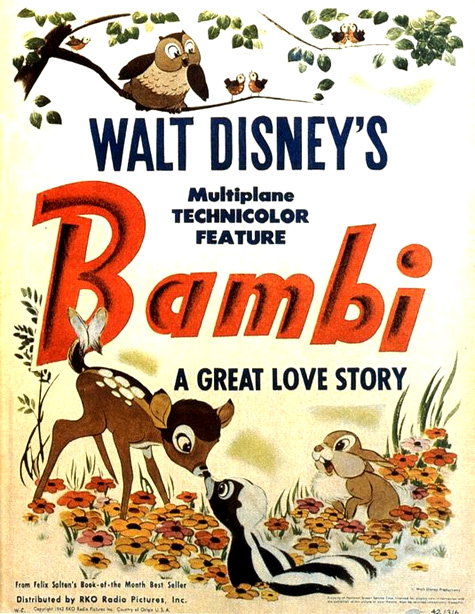
|
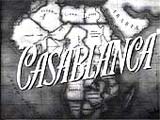
|
Casablanca (1942)
d. Michael Curtiz, 104
minutes, Warner Bros.
- Director Michael Curtiz' best-loved film of all
time, a perennial-favorite, has become a must-see classic. The
much-loved romantic melodrama is
always found on top-ten lists of films. It told a masterful tale
of two men vying for the same woman's love in a love triangle.
The story of intrigue, political and romantic espionage, love lost,
heroism, and conscience was set against the backdrop of the wartime
conflict between democracy and totalitarianism.
- With rich and smoky atmosphere, well-paced dialogue,
a sentimental script, moody and atmospheric sets, anti-Nazi propaganda,
Max Steiner's superb musical score, suspense, unforgettable and
a first-rate cast of memorable characters (supposedly 34 nationalities
are included in its cast) and great lines of dialogue (e.g., "Here's
lookin' at you, kid," and
the inaccurately-quoted "Play it again, Sam"), it has
remained one of the most popular, magical (and flawless) films
of all time.
- The plot was set during World War II in Casablanca
(North Africa) at a seedy Algerian saloon/nightclub run by cynical
saloonkeeper Richard "Rick" Blaine (Humphrey Bogart),
an American expatriate. The Cafe Americain was filled with European
refugees, smugglers, thieves and Nazis. Into his joint walked now-married,
long-lost-love Ilsa Lund Laszlo (Ingrid Bergman) and her underground
Resistance freedom-fighter husband Victor Laszlo (Paul Henreid),
who were trying to arrange their escape from the Nazis. They urged
Rick to help support the French Resistance movement. Vivid memories
of Rick's and the luminous Ilsa's passionate Paris love affair
(just before the Germans occupied the city) ending in betrayal
were shown in flashback. Ilsa asked Rick to help them escape to
neutral Lisbon, because he had two "letters of transit"
- would he give the letters to them, or would she stay with Rick? The
film concluded with the line: "Louis, I think this is the beginning of
a beautiful friendship."
- Woody Allen's Play It Again,
Sam (1972) paid reverential homage to the film, as did excerpts
that found their way into When Harry Met Sally...
(1989).
- From its 8 Academy Awards nominations, the
dark-horse film won three awards (presented in early March of 1944):
Best Picture (producer Hal B. Wallis), Best Director, and Best
Screenplay.
|

|
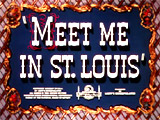
|
Meet Me in St. Louis (1944)
d. Vincente Minnelli, 113 minutes, MGM
- Vincente Minnelli's delightful, classic, nostalgic,
poignant, and romanticized musical film is one of the greatest
musicals ever made - a gem of cinematic, picture-postcard Americana
and youthful romance. It has become a favorite Christmas-time holiday
film classic.
- The Technicolor film marked the beginning of
the golden age of MGM musicals (and legendary producer Arthur Freed's
unit), and ultimately became the second most successful film for
MGM (behind Gone
With the Wind (1939)).
- The film abandoned the 'put-on-a-show' mentality
of so many other backstage song/dance films, or the Busby Berkeley-style
of show-stopping production numbers. Its songs and wonderful performances
were carefully and naturally integrated into the story of the close-knit
family's day-to-day life, and served to thematically advance the
action and plot from one season to the next.
- The film was composed of a series of coming-of-age vignettes
(four in number): different acts representing the seasons
from summer 1903 to spring 1904 that conclude in the year of
the St. Louis World's Fair/Exposition. Each segment marked changes
and rites of passage - and was introduced by a filigreed tintype
from the Smith family album - each static, initially sepia-toned
image turned into color and came to life.
- This film marked the first significant film role,
and probably her career-best effort, for beautiful actress Judy
Garland since The Wizard of Oz (1939).
|

|
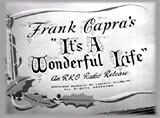
|
It's A Wonderful
Life (1946)
d. Frank Capra, 129 minutes, Liberty Films (Republic Pictures)
- Director Frank Capra's sweet-natured, sentimental,
inspirational classic drama has become a perennial favorite at
Christmastime. Frank Capra regarded this film as his own
personal favorite - it was also James Stewart's favorite of all
his feature films.
- Its main ultimately uplifting message was about
a near-suicidal man, George Bailey (James Stewart) a small-town lender-banker
in Bedford Falls, who learned the value of his existence. The hysterical,
despairing, and melancholy family man was shown what his small
town (Bedford Falls, now renamed Pottersville after the town's
evil tycoon) would be like without him. He was presented with a
frightening, nightmarish, noirish view
of the world (at Christmas-time) that brought him back from self-destruction.
He returned to the idyllic, small-town world that he left, with
renewed faith and confidence in life itself. Hence, the film's
title: It's a Wonderful Life.
- It was actually a box-office flop at the time of
its release, and only became the Christmas movie classic
in the 1970s due to repeated television showings at Christmas-time
when its copyright protection slipped and it fell into the public
domain in 1974 and TV stations could air it for free.
- The picture earned five Academy
Award nominations: Best Picture, Best Actor (James Stewart in his
first film in almost six years), Best Director (Capra), Best Sound
Recording and Best Film Editing, but it won no Oscars.
- Two of its most
memorable lines were: "Look, Daddy. Teacher says, every time
a bell rings, an angel gets his wings," and "A toast - to my big brother George.
The richest man in town."
- A more detailed plot description - charitable,
hard-working philanthropist George Bailey, forced
to remain in a small town by unpredictable circumstances, became
depressed after an accidental financial disaster at his loan company
had benefited the miserly Mr. Potter (Lionel Barrymore). George
was on the verge of committing suicide and wishing that he had
never been born - when his crusty-but-lovable guardian angel Clarence
(Henry Travers), who was desperately trying to earn his wings,
showed up to give him a tour of his town without his presence (Bedford
Falls had become the decadent and hellish Pottersville), showing
him how important he'd been to the lives of his loved ones. Moral
courage, small-town American life, civic cooperation, and family
love were glorified while corporate greed and selfishness were
condemned, climaxed by the man's rescue during an idyllic Christmas
card finale. Clarence earned his wings and George learned that
wealth was measured in love and friendship.
- Adam Sandler's Click (2006) paid homage
to the classic film.
|
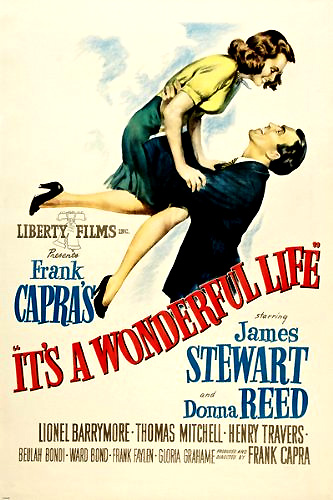
|














